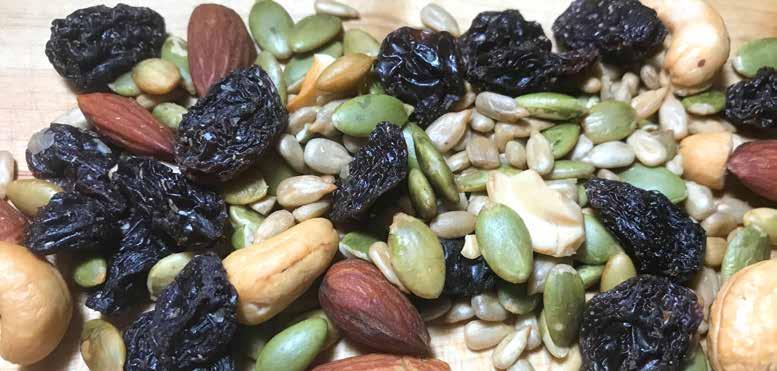
3 minute read
on the table
Photo by Claire Miller
Fuel for Fitness
Nutrition tips to support exercise routines
When dietitian Laura Poland reviews habits with her new clients, she always asks, “How do you fuel your workouts?”
It’s an important question, especially if you hope to make the most out of your time spent working out.
The first step of fueling up for a fitness routine is getting an adequate number of calories each day. Eating enough calories is necessary to improve muscle mass or increase strength, she says.
The second aspect is the timing of when those calories are consumed. Poland, owner of Dietitian in Your Kitchen, recommends her clients consider eating something before every workout, even if it’s in the morning, a more difficult time to fuel. It doesn’t need to be extensive; a small snack of just four to eight ounces of milk or half of a banana, she says, will keep you fueled for an early workout.
“We know when you’re fueling a workout, in order to burn fat, you’re going to need carbohydrates present,” Poland says.
Choosing an afternoon or after-work exercise routine can give you more time to fuel up. Poland says the ideal pre-workout snack is between 200 and 300 calories consumed two hours prior to working out. If you’re only able to eat right before a workout, a piece of fruit or half an energy bar should do the trick without weighing you down.
After getting your sweat on, fueling properly for recovery relies on the ratio of two carbohydrates to one protein within an hour of finishing, Poland says. If you’re heading into dinner after a moderate workout, a balanced meal is a good way to recover. After a high intensity or endurance workout, if a meal with the two-to-one ratio isn’t to follow shortly after, she recommends snacking on half or all of a sandwich or drinking a glass of chocolate milk.
Embarking on a fitness routine with the goal of losing weight comes with additional considerations for nutrition. Once again, getting adequate calories is the main priority in order to achieve fitness and weight loss goals. If the body isn’t getting enough calories, it may hold on to fat instead of shedding it. Poland recommends a calorie deficit that results in no more than one pound of weight loss a week.
“Most of us get plenty of protein, … but it’s really a matter of if you’re not eating enough calories, your body will not be able to reap the benefits of working out,” Poland says. “We’re so crunched for time, the last thing we want to do is go into a workout and not be fueled properly and then just be wasting your time. So I really focus on that when I work with somebody.”
Claire Miller is an editor at CityScene Media Group. Feedback is welcome at cmiller@ cityscenemediagroup.com.
Trail Mix
By Laura Poland, Dietitian in Your Kitchen via BestBaking.com
“I love the versatility and simplicity of this recipe,” Poland says. “For athletes, the best nut to use is pistachios because they contain B vitamins, vitamin A, magnesium, iron, phosphorus, protein, manganese and copper, that helps promote strength and rejuvenation after a workout. When mixed with dried fruit, such as those fruits called for in this trail mix, it helps build back up glycogen stores after a workout.”
• 2 cups total of mixed, chopped dried fruit, such as apricots, apples, cherries, sweetened dried cranberries and blueberries • 1 2⁄3 cups (10-oz. pkg.) Nestle Toll
House dark chocolate morsels • 1 ½ cups total of mixed nuts, such as whole almonds, walnuts, pecans, cashews and pistachios • ½ cup sunflower kernels, chia, flax or pumpkin seed kernels • Note: Dried fruit often has added sugar so watch the ingredient label to keep the sugar content as low as possible. Dried fruit typically has about 15 grams of sugar just from the fruit. So, if a label says there are 30 grams of sugar in ¼ cup serving, then half of the sugar is likely added. Aim for 20 grams of sugar in ¼ cup of fruit.
Combine dried fruit and berries, morsels, nuts and seeds in a large, resealable plastic bag. Makes about six cups of granola. Store in cool, dry place for up to two weeks.





